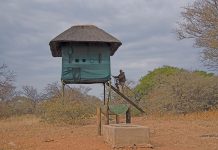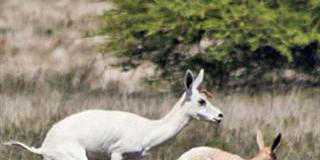
Photo: Gerhard Uys
David Crous and his brothers, Kobus and Riaan, are intensive white rhinoceros breeders in the Free State. While the brothers run their joint venture together, each has his own farm and animals. According to David, cattle farmers could easily diversify into rhino breeding without making too many infrastructural changes to their farms.
READ Cattle farmers learn how to farm game
The brothers have always been cattle, maize and potato farmers, and introduced game such as buffalo, sable and roan into their operations in 2002. After investigating the profitability of adding a rhino breeding enterprise, the brothers sold some of their game component to finance their new venture. In 2008, they bought their first herd of eight white rhino cows and one bull.
David says that the past few years have been a surprising learning curve, with many of their previous beliefs on rhino management proving wrong. However, the health of their rhino and the continued production of their now over 200-strong rhino herd is confirmation that their approach is working.
The Crouses’ rhino breeding programme is founded on six principles: habitat and feed, camp size, social structure and behaviour, reproduction, general management, and economics and investment.
Habitat and feed
White rhino are grazers, and existing Smuts finger pastures and natural veld are ideal for their diets. As the brothers each had a cattle component on their respective farms, they simply adjusted their camps accordingly to accommodate the rhino.
When the brothers first bought in rhino, the Free State Department of Environmental Affairs and Nature Conservation (DEA) was involved in the issuing of permits, and offered the brothers advice on their lands’ carrying capacity. According to the DEA, 50ha/rhino were required to ensure sustainability.
“After conducting habitat studies, we agreed we’d adhere to the 50ha/animal guideline and provide extra feed in winter,” David recalls. “We also told the DEA that if 50ha/rhino proved to be too small, we’d move rhino to adjacent camps, but if it proved large enough, we wanted permission to add rhino on a trial basis to see what the real carrying capacity was on a 300ha camp. Initially, veterinarians and the DEA visited us often, as they were sceptical about breeding in the Free State. Today, it’s a different story.”
After trial and error, 50ha/rhino has proved an unnecessarily low stocking rate, and the Crouses are currently able to farm 12 breeding cows with calves at foot, one breeding bull and a teaser bull on 300ha.
The sweet Free State red grass and about 40ha of Smuts finger grass per camp are adequate to keep cows in good condition. From April until the beginning of the rainy season, this is supplemented with teff bales. For a breeding herd of 15 rhinos, four 200kg teff bales are used twice a week.
In captivity, an adult rhino consumes about 75kg/day. Initially, additional supplementary feeding was provided, but the Crouses later learned that this had an adverse effect on the fertility of some cows, which failed to conceive.
Initially, conservation services told the Crouses that tall grass was unsuitable, as rhino feed only on short grass.
“We slashed the grass, but the rhino didn’t eat it. We think the shorter stubs were too hard and stung their lips. Rhino are happy with tall grass, and simply start cropping it shorter from one side, and eat the soft shoots as it grows back,” David says.
Camps
A 500ha camp with 30 rhino cows and calves is the highest acceptable stocking rate, according to the brothers. Space is essential, as rhino do not gather in a single herd; instead, they split into various groups daily to graze different parts of the camp. One breeding bull is kept with each breeding herd.
The Crouses erected 2,4m electrified fences around the initial camps. At first, animals that arrived from the Kruger National Park were kept in bomas for about three weeks to allow them time to accept the fences and adapt to human companionship.
However, after four years of experimenting with fence heights, the brothers discovered that this was unnecessary.
“The first group was kept in a boma for three weeks,” David explains. “Later we kept new groups in boma for two weeks, then one week, then three days. We eventually learnt that if we place dung in the corners when new animals arrive, they realise there are other rhino around and stay calm. But we do have a veterinarian inject them with a slight sedative that lasts three days to assist adjustment. When buying in new animals from national parks, one out of 10 will try to break out, but the dung method and tranquilliser help adaptation.”
David says fences of 1,8m are sufficient. Each camp is divided by a 300m barrier to separate breeding bulls from each other.
Reproduction
Bulls begin mating between the ages of eight and 10 years, and heifers begin mating between the ages of five and six years. In nature, cows have been known to breed for up to 40 years, but with his animals kept in perfect condition on his farm, David expects that they may be able to breed for longer.
READ Dr Dave Cooper at the frontline of rhino poaching
The inter-calving period (ICP) for the Crouses’ top-performing cow is 19 months, with other cows averaging an ICP of 20 to 21 months. Cows and their calves are kept together until the calf is weaned at between 12 and 18 months of age.
While the brothers always attempt to wean a calf before its mother calves again, it is not unusual for a cow to run with two calves. The gestation period is 16 months.
With a 50kg calf and an almost 2t mother, calving is relatively easy. Weaning is also easy: the calf is darted and moved to another camp. At weaning, bulls and heifers are separated and placed in their own camps.
Teaser bulls
A teaser bull aged between three and four years is placed in each breeding herd. This bull is too young to challenge the breeding bull, yet his presence is essential for triggering the latter’s mating behaviour. If at the age of six or seven, the young bull starts challenging the older bull, it is replaced.
The Crouses have used teaser bulls since the beginning of the operation and achieve, on average, a 95% calving and weaning rate.
Determining whether or not a bull is sexually mature can be difficult, but one sign is that the animal sharpens its horn.
The brothers never select bulls based on the length of the larger horn, as this is largely insignificant. Rather, they select according to horn diameter, with a 32” (81cm) diameter at the base of the horn being the minimum requirement.
Social structure
If a bull shows aggression towards new-born calves, it is sold for hunting, as a bull like this will always display aggressive behaviour. Cows, heifers and young bulls can, however, be trusted with one another, and when introducing new animals into camps, David has never experienced any problems.
Cows stay with new calves, separated from the herd, for at least two weeks, and never stray farther than 10m from their calves. Horses and riders are used to reunite a cow and her calf if they are separated.
“Cows that are separated from calves for more than a few hours will not take them back. Labourers on horseback keep an eye on herds a few times a day to make sure new calves stay with their mothers.
“Hand-raising a calf is difficult and in the odd case where a cow and calf are separated, we take calves to a sanctuary that specialises in hand-rearing them,” David says.
Horn harvesting
The Crouses use ear notches to identify animals, as tags are often lost in the mud baths.
Horns are harvested every two years in the presence of nature conservation officers, and each is microchipped and registered after harvesting before being stored in an off-farm facility.
Horns grow two to four inches (between 5cm and 8cm) a year, and are harvested 10cm from the base. Cutting lower than this risks penetrating soft tissue.
Harvesting the horn also helps protect the animals against poachers.
Economics
The Crouses decided to invest in rhino as the return on investment (ROI) – based solely on live sales – is typically around 15%. In cattle, it is between 6% and 8% for a cow/calf combination.
“But everyone makes their calculations differently. We already had the land and the fencing for other game, so didn’t factor that cost in,” David explains.
The Crouses look forward to a day when the trade in rhino horn is legalised.
“It’s the only commodity that game farmers can sustainably grow without killing the animal,” David says.
He does not recommend that farmers finance a rhino herd through a loan, but purchasing the animals is expensive. When the Crouses launched their operation, a rhino cow sold for an average of R250 000. Last year, cows with heifer calves at foot sold for an average of R700 000. But prices fluctuate, says David.
He stresses that embarking on any venture must be economically feasible, and while an aspiring rhino breeder can start small, it makes more sense to start with a larger herd, as the management and infrastructure is the same as for a smaller one.
For more information contact David Crous on email at [email protected].













